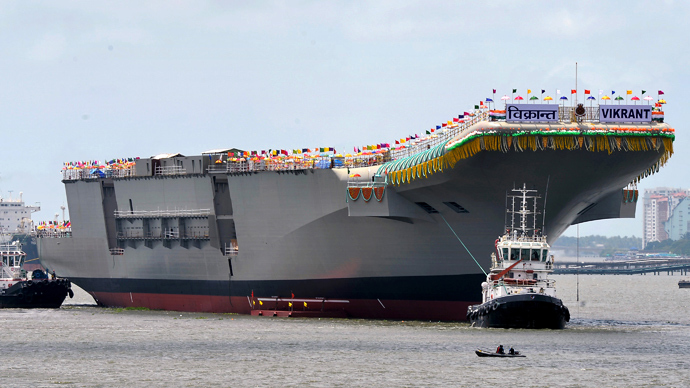India launches first home-built aircraft carrier

India has launched its first domestically built aircraft carrier on Monday, joining the world’s military elite. It comes two days after the activation of India’s first nuclear submarine, a move hailed as a "giant stride in technological capabilities.”
The INS Vikrant will be launched two years behind schedule at a
reported cost of around $7.7 billion. The completion of the first
stage of the 37,500-ton vessel’s construction marks India’s entry
into the elite group of military superpowers capable of designing
and building an aircraft carrier. The other nations are Britain,
France, the US and Russia.
The delays were reportedly caused by problems sourcing
specialized steel from Russia.
"It's a remarkable milestone," Defence Minister A.K.
Antony said as he stood in front of the giant grey hull of the
ship at a ceremony in the southern city of Kochi. "It marks
just a first step in a long journey but at the same time an
important one."
Following its first voyage the Vikrant will re-dock so that
construction can be completed on the ship’s control systems and
living quarters. Once building is finished the vessel will
undergo rigorous trials in 2016 and is expected to enter active
service in 2018.
The keel of the home-built Indian ship is almost completely
constructed from high-quality, indigenously-produced steel.
The state of the art Vikrant has the capacity to hold 36 fighter
planes, with the time interval between take-offs from the vessel
as low as three minutes. This period can be reduced to less than
two minutes, say Indian naval officials.

India has recently invested billions of dollars in upgrading its
military and according to KPMG estimates, the country will shell
out a further $112 billion on defense acquisitions between 2010
and 2016. On Sunday the government announced the activation of
the first nuclear-class submarine to be designed and built in
India. Prime Minister Manmohan Singh called it a "giant
stride" for the nation.
The addition of the vessel to India’s naval fleet will add a new
facet to the country’s military capabilities as previously it was
only able to launch missiles from land and from the air.
The INS Arihant (Destroyer of Enemies) is part of an Indian
initiative to construct 5 vessels capable of launching
nuclear-tipped missiles and torpedoes.
The Indian government aims to modernize its soviet-era military
hardware. At present India has one aging British aircraft carrier
that was handed over by the UK in 1987.
The new additions to India’s arsenal will enforce its military
presence in the region as China’s influence continues to grow.
Analysts say that overall India is lagging behind China in terms
of its military capabilities.
C. Uday Bhaskar, a retired naval officer and former director of the National Maritime Foundation in New Delhi, said the ship would "enhance India's credibility" but it "would not alter the balance of power with China".















